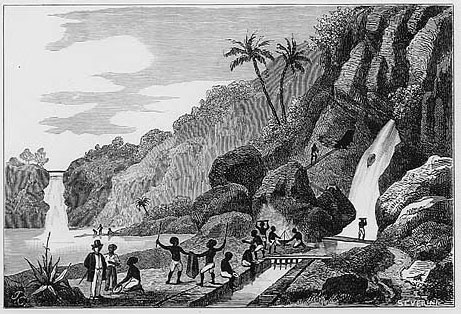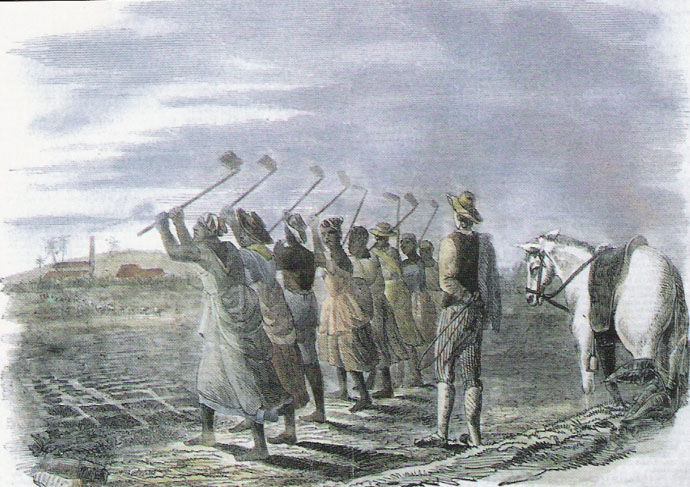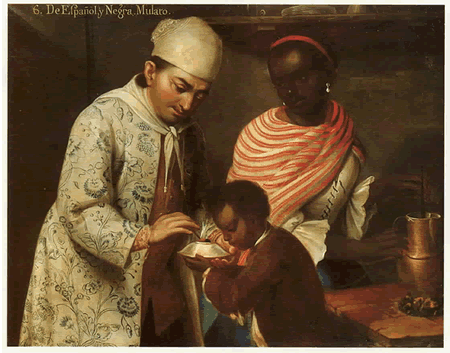The Atlantic slave trade was one of the most important examples of forced migration in human history. While slavery in the U.S. is well-documented, only ten percent of the slaves imported from Africa came to the United States; the other ninety per cent were disbursed throughout the Americas—nearly half went to Brazil alone. Where did they go? What did slavery look like in other parts of the New World? And what are the lingering effects on the modern world?
Guest Natalie Arsenault from the University of Chicago explores the oft-ignored impact of the slave trade on other parts of the Americas.
Guests
 Natalie ArsenaultAssociate Director of the Center for Latin American Studies at the University of Chicago
Natalie ArsenaultAssociate Director of the Center for Latin American Studies at the University of Chicago
Hosts
 Christopher RosePostdoctoral Fellow, Institute for Historical Studies, The University of Texas at Austin
Christopher RosePostdoctoral Fellow, Institute for Historical Studies, The University of Texas at Austin
It’s important to discuss slavery as a historical phenomenon, both inside and outside of the U.S. 80% of African slaves went to Brazil or to the Caribbean. In contrast, only 10% went to the U.S., where slavery was maintained through natural reproduction among the slave population as opposed to the constant supply of new slaves from Africa. In order to present the big picture to students, we should compare the slave trade and slavery across the region as a whole.
Development of slave trade
The Portuguese went to Africa in 15th century looking to bypass Muslim North Africans who had a monopoly on the sub-Saharan trade in gold and spices. As they explored and traded in West Africa, the Portuguese learned that money could be made by transporting slaves along the Atlantic coast to Muslim merchants.
In addition to trading in Africa, the Portuguese began to export small numbers of slaves to Europe, to work in the cities. At the end of the 15th century, about 10% of the population of Lisbon (one of the largest cities in Europe) was African. Also, at this time, Europeans established sugar plantations on the islands off of Northwest Africa and the slave trade to those islands became profitable. I want to highlight this because the use of slave labor for plantation agriculture foreshadows the development of slavery in the Americas.
Soon enough, other countries became interested in the profitable slave trade. English and Dutch ships joined in. They would raid Portuguese ships as well as going onto the mainland to enslave Africans for the trade.
 When Europeans began to explore the Americas, Africans were part of most expeditions to the region. The Spanish brought them in the early 16th century to work on sugar plantations and in gold mines on the island of Hispaniola (current-day Haiti and the Dominican Republic). Slaves were also put to work draining the shallow lakes of Tenochtitlán, the Aztec capital, in Mexico.
When Europeans began to explore the Americas, Africans were part of most expeditions to the region. The Spanish brought them in the early 16th century to work on sugar plantations and in gold mines on the island of Hispaniola (current-day Haiti and the Dominican Republic). Slaves were also put to work draining the shallow lakes of Tenochtitlán, the Aztec capital, in Mexico.
The slave trade increased in the seventeenth century, as more large-scale agricultural production increased the need for labor. The demand for sugar, a highly profitable crop that grew well in various parts of the Americas, continued to grow. And the Europeans introduced large-scale production of indigo, rice, tobacco, coffee, cocoa, and cotton. Imports of African slaves increased over the latter half of the 17th century and into the 18th. Approximately 1.3 million slaves were exported on the trans-Atlantic route in the 17th century; over 6 million were exported in the 18th century.
The end of the trans-Atlantic slave trade began in the early 19th century, with bans on the importation of slaves in Britain and the U.S. in 1807. International pressure, as well as British blockades of slave ships, led to the decline of the slave trade, which had mostly ended by the 1850s.
The effects of the slave trade on West Africa were massive, especially in terms of demographics. When we look at slave trade maps over the centuries (and there are some on the website), we can see that West African populations were vastly reduced to the point where slave traders were launching further into the interior of the continent to purchase slaves. The coastal areas couldn’t feed the European demand for slave labor. In addition to the loss of able-bodied workers to the Americas, the slave trade caused wars and slave raids that brought about additional deaths, as well as environmental destruction. Only a few traditional kingdoms (like Benin, a kingdom in southern Nigeria) were able to limit the trade or regulate it with local law. In the end, though, few were successful over the long haul: these small, centralized kingdoms were not very effective at resisting the slave trade and their populations dwindled as European demand and greed increased.
Brazil
By the time the Portuguese started to pay attention to Brazil, they had been active in the slave trade for nearly a century. Although the Portuguese arrived in Brazil in 1500, they only established a strict bureaucracy in 1549—to fight off French and British incursions.
We have to remember: Europeans were exploring the American continents throughout the sixteenth century, with each aspiring imperial power trying to find land and profitable resources to claim for itself. Explorers were delving deeper into the continents and “entrepreneurs” were finding products to send back to European markets. Brazil is actually named for its first primary sector export: brazilwood.
In the mid-16th century, sugar plantations began to spring up in the Northeast, where sugar grew well. The colonists looked to the Indians to provide the necessary work force for this labor-intensive crop. However, the enslaved Indians quickly fell victim to European diseases (an important aspect of the Columbian Exchange) or fled to the unnavigated interior of the country. The Portuguese decided that the Indians were too fragile for plantation labor and, already active in the Atlantic slave trade, they began to import African slaves. Soon, the sugar plantation system became entirely dependent on African slave labor.
 While slaves were initially brought in to provide labor for the sugar plantations, the eventual overabundance of African slaves caused them to be used in almost all areas of the economy. Slaves were distributed in Brazil based on the primary export of the time, depending on where they were needed for work: first, on the sugar plantations in the Northeast, then in the gold mines of the Southeast, on the coffee plantations of the South, and in the major cities of Salvador and Rio de Janeiro as household servants. By the late 18th century, about half of the households in Brazil’s most prominent cities held slaves. The slave trade, which allowed for the constant importation of inexpensive labor, allowed Brazil to develop several major industries and filled their need for most manual labor in almost every profession.
While slaves were initially brought in to provide labor for the sugar plantations, the eventual overabundance of African slaves caused them to be used in almost all areas of the economy. Slaves were distributed in Brazil based on the primary export of the time, depending on where they were needed for work: first, on the sugar plantations in the Northeast, then in the gold mines of the Southeast, on the coffee plantations of the South, and in the major cities of Salvador and Rio de Janeiro as household servants. By the late 18th century, about half of the households in Brazil’s most prominent cities held slaves. The slave trade, which allowed for the constant importation of inexpensive labor, allowed Brazil to develop several major industries and filled their need for most manual labor in almost every profession.
Over the centuries, Portugal exploited different parts of Africa. In the 16th century, Senegambia provided most of Brazil’s slaves; in the 17th century, Angola and the Congo rose to dominance; and in the 18th century, slaves were coming from the Mina Coast and Benin. “Without Angola no slaves, without slaves no sugar, without sugar no Brazil” was a common expression during the 17th century. During the last 50 years of the slave trade, large numbers of Yoruba people (from the area that is currently Nigeria and Benin) were brought to cities in Northeastern Brazil, resulting in a lasting impact on the culture of that region.
African slaves were brought into Brazil as early as 1530, with abolition in 1888. During those three and a half centuries, Brazil received 4,000,000 Africans, over four times as many as any other American destination.
The slave trade lasted longer in Brazil than in almost any other country in the Americas. Slavery was abolished in the British and French Caribbean, the United States, and Spanish America a generation or more before it was abolished in Brazil. When Brazil gained independence, in 1822, slavery was such an entrenched part of the system that the elites who structured the new nation never seriously debated the issue. We should note here that slavery in Brazil was justified by the need for labor, but slavery was rarely defended on racial grounds; for the Portuguese the key issue was legal status, not race. Not only was the slave trade continuing, the same number of Africans (1.7 million) entered Brazil between 1800 and 1850 as during the entire 18th century. The late date of abolition, and the high numbers of slaves that entered Brazil late into the 19th century, contributed to the country’s cultural connection to Africa.
Brazil’s slave trade lasted two generations longer than that of the U.S., and more slaves were African-born than in the U.S. This has led to a Brazilian connection to Africa that has not been as present in the United States. The transference of African culture, in these circumstances, was much more direct than in the U.S., where links to Africa were relegated to stories of one’s ancestors rather than to one’s own experience. Only recently have U.S. African-Americans begun to develop that connection with Africa in a way that more closely resembles the situation in Brazil.
The lingering effects of the slave trade—and the institution of slavery—can be seen every day in Brazilian cuisine, religion, music, and dance. It can be seen in the people, in a black and brown population that is larger than the population of every African country except for Nigeria.
Haiti
The island of Hispaniola was originally settled by the Spanish, due to its key location as a launching place for conquests of new territory in the Americas. The Spanish introduced slavery and small-scale sugar production almost immediately. The first slaves were Taíno Indians, who dwindled from a population of hundreds of thousands in 1492, to 150 in 1550. As the indigenous population was dying of abuse and disease, African slaves were brought in; the first 15,000 Africans arrived in 1517. Although the Spanish settled on the eastern part of the island, they focused their attention on their more prosperous colonies in other parts of the Americas. This led, in the early 1660s, to an incursion into the western part of the island by the French. In 1697, after decades of fighting over the territory, the Spanish ceded the western part of the island to the French, who henceforth called it Saint-Domingue (which eventually became Haiti; for our purposes, I’ll refer to it as Haiti).
The French were very involved in the trans-Atlantic slave trade, just behind the Portuguese and the British in terms of volume. Between the end of the 17th century, around the time that they settled on Hispaniola, and the mid-19th century, the French made more than 4,000 registered slaving trips to the Americas. So, much like the Portuguese, the French had easy and regular access to slave labor. The French originally cultivated indigo but quickly exhausted the soil. Indigo might not have worked, but that wasn’t due to a labor shortage. They quickly moved on to another labor intensive, and even more profitable, crop: sugar.
More than 100 sugar plantations were established between 1700 and 1704. Sugar production was very profitable and Haiti quickly became the richest of France’s colonies. As sugar expanded, so did the slave population. By 1720, the French were importing 8,000 slaves each year from Africa. Haiti was the main destination for most of the slaves carried across the Atlantic on French ships. An interesting note about the triangular trade is that ships criss-crossed the ocean loaded with valuable goods (whether that be textiles, slaves, or sugar), but almost no money. This whole system worked by barter, with slaves being traded for sugar (although slaves were worth twice as much as the sugar; later, boats would have to travel to France to bring the rest of the sugar that was owed to the slave traders).
When the French began to plant coffee, around 1734, profits in Haiti soared and more slaves were needed for yet another labor-intensive crop. Haiti was soon producing 60% of the world’s coffee. Crop expansion required additional labor, as did the high mortality of the slave population due to harsh working conditions. The average life span of a slave in Haiti was less than seven years. By the mid-18th century, more than 10,000 slaves arrived each year, with more than 40,000 arriving in 1787. By then, there were nearly half a million slaves in Haiti and 2/3 of those slaves were African-born.
Easy access to slaves coupled with soaring profits from cash crops created a situation in which the slave population of Haiti vastly outnumbered free colonists. But somehow, even with inferior numbers, the French were able to establish a system in which the lopsided population didn’t work against them: for a century, they didn’t face a massive slave revolt. However, as time wore on, and as the rich plantation owners and working class colonists fought amongst themselves over their relationship (and privileges) with France, the slaves, who outnumbered the free population more than 10 to 1, began to organize. Eventually, their organization led to the Haitian Revolution, which we’ll discuss in greater detail in another episode.
 This hegemony, in which a French minority ruled a large enslaved population, was possible due to the French belief in their socio-political superiority which resulted in their strict, and often violent, control of the slave population. The French believed that they were superior to the people they conquered and the people that they enslaved. Whereas the Portuguese were defending slavery on the basis of the need for labor, the French justified it on racial grounds. They were invested enough in the concept of their racial superiority that during the colonial period they tracked people’s racial heritage into 128 parts (which is six generations, so think about this as tracking your ancestry back to your great-great-great-great grandparents). They were focused on how that ancestry broke down between European and African roots. A European had to have 128 parts European heritage, an African had 128 parts African heritage, a mulatto was half-half (or 64/64). The true obsession was shown in the categories in between. Even someone who had 125–127 European parts was called “mixed blood” in Haiti.
This hegemony, in which a French minority ruled a large enslaved population, was possible due to the French belief in their socio-political superiority which resulted in their strict, and often violent, control of the slave population. The French believed that they were superior to the people they conquered and the people that they enslaved. Whereas the Portuguese were defending slavery on the basis of the need for labor, the French justified it on racial grounds. They were invested enough in the concept of their racial superiority that during the colonial period they tracked people’s racial heritage into 128 parts (which is six generations, so think about this as tracking your ancestry back to your great-great-great-great grandparents). They were focused on how that ancestry broke down between European and African roots. A European had to have 128 parts European heritage, an African had 128 parts African heritage, a mulatto was half-half (or 64/64). The true obsession was shown in the categories in between. Even someone who had 125–127 European parts was called “mixed blood” in Haiti.
So, while the massive and continued importation of African slaves allowed Haiti to become France’s richest colony in the New World, it also created a highly hierarchical and racialized structure in which the French elite were convinced of their superiority, in every way. It came as quite a shock to them when the slaves revolted, and their refusal to let go of the colony led to a 13-year war that eventually devastated the landscape that had been so profitable.
Spanish colonies
Although the numbers of slaves that ended up in Haiti and Brazil were far greater, the Spanish were also buying slaves to work in their colonies. The primary difference here was that the Spanish were not as active in the slave trade directly from Africa, and were more often purchasing slaves from British and Dutch traders.
As I mentioned before, African slaves were with the Spanish from the very beginning. It’s rather ironic that African slave labor helped the Spanish as they completed the conquest of the Aztecs in Tenochtitlán. Slaves were also put to work in the sugarcane and rice fields of Mexico, along the coast of Veracruz. The numbers were significantly smaller than in Brazil and Haiti, however, with a slave population of only 16,000 in all of Mexico in the mid-18th century. Still, the black population outnumbered the Spanish settlers in the colony.
Like in Mexico, slaves traveled with the conquistadors of Peru. Francisco Pizarro received a permit to bring in slaves for public construction: they built the first Spanish roads and bridges (although the Inca infrastructure had already been in place).
The Spanish colonies where sugar or mining were king employed considerable slave labor: Cuba, Venezuela, Colombia, Ecuador, Peru. In other parts of Spanish America where large-scale agriculture or extractive industries weren’t the main economic sector, such as Argentina and Costa Rica, slaves were used in artisan and domestic work, but their numbers were never very large. Still their presence wasn’t insignificant: Africans were nearly one-third of the population of Buenos Aires in the early 1800s.
 Like the French, the Spanish justified slavery on racial grounds; like the French, they focused on each person’s ancestry. In Mexico, they created a series of “casta paintings” (casta being the Spanish word for caste) in which they literally illustrated the various racial categories. Through these paintings, you would learn that someone who had a Spanish parent and a mestizo (half Spanish, half Indian) parent was a castizo…and so on. Dozens of racial categories were defined in these casta paintings. Because the Indian populations in Mexico were greater than in Brazil and Haiti, many of the racial categories focused on that mixing, but African mixes were also included. As in Haiti, the presence of African slaves in Mexico contributed to the Europeans’ concerns with race and racial purity. A lot of time was spent distinguishing Europeans from the indigenous, African, and mixed populations, all of whom they considered inferior.
Like the French, the Spanish justified slavery on racial grounds; like the French, they focused on each person’s ancestry. In Mexico, they created a series of “casta paintings” (casta being the Spanish word for caste) in which they literally illustrated the various racial categories. Through these paintings, you would learn that someone who had a Spanish parent and a mestizo (half Spanish, half Indian) parent was a castizo…and so on. Dozens of racial categories were defined in these casta paintings. Because the Indian populations in Mexico were greater than in Brazil and Haiti, many of the racial categories focused on that mixing, but African mixes were also included. As in Haiti, the presence of African slaves in Mexico contributed to the Europeans’ concerns with race and racial purity. A lot of time was spent distinguishing Europeans from the indigenous, African, and mixed populations, all of whom they considered inferior.
Whether in large numbers or relatively small, African slaves drove the economies of the New World colonies. Their labor helped to build the infrastructure of the region and the riches of European nations. European domination of the slave trade allowed easy access to inexpensive labor—labor that was also deemed highly expendable—which in turn allowed European powers to exploit the resources of the Americas for three hundred years.
Related Episodes
- Episode 11: The Haitian Revolution
- Episode 105: Slavery and Abolition
- Episode 42: The Senses of Slavery
- Episode 54: Urban Slavery in the Antebellum United States
- Episode 76: The Trans-Pacific Slave Trade
- Episode 88: The Search for Family Lost in Slavery
- Episode 109: The Tango and Samba
- Episode 98: Brazil’s Teatro Negro and Afro-Brazilian Identity